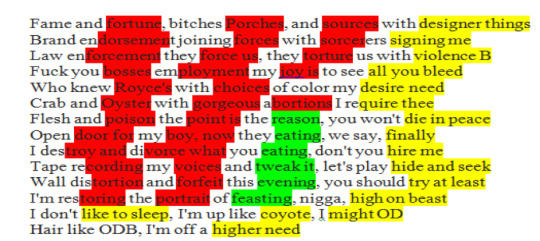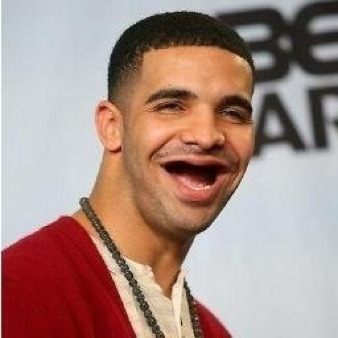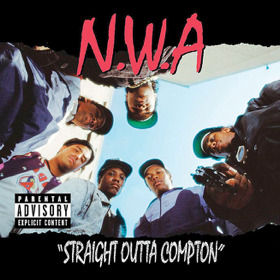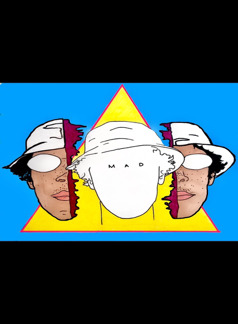Don't wanna be here? Send us removal request.
Text
HIP-HOP IS HIP PART 3
We’ve taken a look at how Hip-Hop has grown in popularity since its birth in the late 1970’s, but have not really considered the sound of Hip-Hop and how it has evolved. Hip-Hop is an interesting genre because it is one that takes samples from other music and re-creates it in an original way. This is evident in the birth of Hip-Hop. The change in the sound of Hip-Hop helps explain its evolution as a genre and how it has risen to be one of the most popular genres of music today.
When Hip-Hop first started in the Bronx in the late 70’s, the actual music was not new, but the way it was played was revolutionary. This was a time where disco music dominated the culture. In most clubs and on radio stations disco music was being played. Disco didn’t cater to everyone, however, including DJ Kool Herc. DJ Kool Herc is credited with “inventing” Hip-Hop, giving people like himself who didn’t identify with the mainstream norm something to listen to. DJ Kool Herc used turntables and a DJ mixer to play popular songs, but only the percussion breaks of these songs. He was not playing new music, but just playing it in a new way. This was revolutionary, people could dance for hours just to the funky break in popular disco songs. This technique was mastered by DJ Grandmaster Flash who actually scratched the records, something that was previously taboo. (https://www.youtube.com/watch?v=JHIsNQ3eh2g Grandmaster Flash in action)
“Break” dancing comes from this break in the song, the part being played at the early block parties in the Bronx. DJ’s started having mics with them so they could hype up the crowd. This crowd hype transitioned into the art known as emceeing, the so-called “rap” part of Hip-Hop music today. In early Hip-Hop emcees used simple cadences and rhymes, but that has evolved over time.( https://www.youtube.com/watch?v=rKTUAESacQM The Sugar Hill Gang’s hit “Rappers Delight” was the first Hip-Hop song recorded and took the nation by storm) Rappers today like Kendrick Lamar use rhyme schemes that even Shakespeare would be impressed by.

The lyrical content of Hip-Hop in the early years catered to a party vibe, but this changed in 1982 when Grandmaster Flash and the Furious Five released their song “The Message”. (https://www.youtube.com/watch?v=O4o8TeqKhgY) This brought in a new era of Hip-Hop, one that spoke of societal concerns, especially for urban African-Americans who were being mistreated. This era of conscious rap is usually referred to as the “Golden era” of Hip-Hop, stretching from the late 80’s to the late 90’s. During this time period, not only was the lyrical content of Hip-Hop influencing cultures around the U.S., but the sounds being produced were diverse, innovative, and original. Groups like Run DMC were fusing a rock and roll sound with the boom-bap feel of Hip-Hop. Other groups like Public Enemy had a much grittier and raw aesthetic to them, really trademarking that boom-bap sound. (Run DMC https://www.youtube.com/watch?v=4B_UYYPb-Gk Public Enemy https://www.youtube.com/watch?v=8PaoLy7PHwk)
The golden era of Hip-Hop lost the funky feel that was heard in the beginning of Hip-Hop music as they were no longer using funk and disco as the primary samples. The invention of the drum machine helped with this as producers no longer needed the breakdown for the percussion in their songs. This helped to diversify Hip-Hop as the possibilities for sounds were now endless. Hip-Hop regained its lost funkiness when ‘Gangsta Rap’ emerged, a sub-genre depicting gang culture in Southern California. Gangsta Rap had a very g-funk feel to it, primarily sampling funk music. Producer and member of the group NWA Dr. Dre really trademarked this sound. (https://www.youtube.com/watch?v=_CL6n0FJZpk) The lyrical content of this era caused quite the commotion; rappers graphically described the “Gangsta” life, one that is violent. This was concerning to most of white America as Gangsta Rap drew in a large white crowd, and romanticized their violent lifestyle to them. People thought that because their kids listened to violent music they would start acting violent.
In the early 2000’s Hip-Hop continued to diversify. An R&B-esque sound was very popular, but there were artists like 50 Cent whose music had a very dance-y and groovy feel to it. (50 Cent https://www.youtube.com/watch?v=5qm8PH4xAss) Eminem was one of the first white rappers who became popular and respected in the Hip-Hop scene. This attracted even more white listeners to the genre. Kanye West was producing Hip-Hop music that was revolutionary at the time and that still heavily influences the sound of Hip-Hop today. (https://www.youtube.com/watch?v=Jr_5yTNvIt4) His style consisted of a lot of sampling from soul music, and the vocals in these samples was something that was never really done before. This era showed a significant amount of diversity and growth in Hip-Hop, birthing many new sub-genres in Hip-Hop.
Lil-Wayne and Gucci Mayne were the pioneers to the modern sound of Hip-Hop, or at least mainstream Hip-Hop. “Trap” music dominates the industry, and is influenced by a very-southern sound. Hi-Hats and loud 808 basses is trademark to this music. Rappers like Future are some of the most popular right now, but this brings a lot of controversy to older Hip-Hop listeners as the genre has stemmed greatly from where it once began. (https://www.youtube.com/watch?v=xvZqHgFz51I) The Trap in Trap music refers to a place where drug deals take place, so this also causes a lot of controversy with old school Hip-Hop heads as some claim there is no more lyrical content in Hip-Hop. Rappers like Kendrick Lamar disprove this though. Kendrick Lamar’s song “Alright” was an anthem for protestors during the Ferguson protests, giving hope to African Americans across the country saying they would be “alright”. (https://www.youtube.com/watch?v=Z-48u_uWMHY) Drake is the most popular rapper to date, and one of the most popular artists in history. He has continued to break sales records, using a Pop style and appealing to a larger audience.
Hip-Hop has diversified greatly from where it once began, and it will be interesting to watch the genre grow in the future, as artists continue to innovate and revolutionize the sound.
References
Wheeler, Darby, director. Hip Hop Evolution . 2016, www.netflix.com/title/80141782.
Rolanndd. “Grandmaster Flash - Wildstyle.” YouTube, YouTube, 25 May 2010, www.youtube.com/watch?v=JHIsNQ3eh2g. Accessed 26 May 2017.
Dutchmanmm. “The Sugar Hill Gang - Rapper's Delight ( HQ, Full Version ).” YouTube, YouTube, 20 Oct. 2010, www.youtube.com/watch?v=rKTUAESacQM. Accessed 26 May 2017.
i.imgur.com/ZJ0PXNl.png.
Chechkmyvids. “Grandmaster Flash The Message HQ.” YouTube, YouTube, 8 Apr. 2009, www.youtube.com/watch?v=O4o8TeqKhgY. Accessed 26 May 2017.
Kfidgs. “Public Enemy - Fight The Power.” YouTube, YouTube, 9 Sept. 2008, www.youtube.com/watch?v=8PaoLy7PHwk. Accessed 26 May 2017.
RUNDMCVEVO. “RUN-DMC - Walk This Way.” YouTube, YouTube, 25 Oct. 2009, www.youtube.com/watch?v=4B_UYYPb-Gk. Accessed 26 May 2017.
DrDreVEVO. “Dr. Dre - Still D.R.E. Ft. Snoop Dogg.” YouTube, YouTube, 27 Oct. 2011, www.youtube.com/watch?v=_CL6n0FJZpk. Accessed 26 May 2017.
50CentVEVO. “50 Cent - In Da Club (Int'l Version).” YouTube, YouTube, 16 June 2009, www.youtube.com/watch?v=5qm8PH4xAss. Accessed 26 May 2017.
Mercuryrecordsuk. “Kanye West - Through the Wire.” YouTube, YouTube, 5 Mar. 2008, www.youtube.com/watch?v=Jr_5yTNvIt4. Accessed 26 May 2017.
FutureVEVO. “Future - Mask Off.” YouTube, YouTube, 5 May 2017, www.youtube.com/watch?v=xvZqHgFz51I. Accessed 26 May 2017.
KendrickLamarVEVO. “Kendrick Lamar - Alright.” YouTube, YouTube, 30 June 2015, www.youtube.com/watch?v=Z-48u_uWMHY. Accessed 26 May 2017.
0 notes
Text
HIP-HOP IS HIP PART 2
Hip-Hop started in the streets of the Bronx in the 70’s, which is not too long ago. This underground scene is now a global phenomenon, as Hip-Hop superstars like Kanye West and Drake tour the globe. Fans in different countries are desperate to see these artists, and tickets usually sell out within days.

Hip-Hop’s unique evolution was discussed in the previous article, but the question of why Hip-Hop has had the success it has is still unanswered. This is a question in which there is no simple answer. Hip-Hop is a complex genre built on the ideas of a complex world. Primarily the world of less privileged urban African-Americans. This article aims to answer the question of how Hip-Hop became successful, while incorporating many societal problems concerning Hip-Hop.
ORIGINS
For a refresher, Hip-Hop was created in the Bronx in effort to unite the divided community. It was primarily underground for the first 7-8 years, until the first Hip-Hop record was recorded and gained exposure all over the nation. However, Hip-Hop remained a genre primarily catered to African-Americans throughout the 80’s and 90’s. This period is usually referred to as the “Golden Age” of Hip-Hop. Most of the music during this time was politically charged, acting as a voice for the oppressed African-Americans in the country. “Gangster Rap” was also created during this time. (Wheeler)
GANGSTA RAP
This sub-genre of Hip-Hop originated out of California, and was arguably the first west coast rap. It gave insight to a brutal world most Americans didn’t know existed; a world of crime, a world of violence, a world of drugs, and a world of gangs. Gangster Rap was raw, and that’s why it was so appreciated. It was a real testimony to the atrocities these people were living. Gangster Rap exploded, but in areas one might not have guessed it would.

During this time period of Gangster Rap, Hip-Hop found its way into the tape and CD players (LOL) of white suburban teens. Maybe it was because of the way Hip-Hop was romanticizing gangs and violence, bringing out a more masculine version of the white listener’s self, or maybe they just liked the way the music sounded. Either way, Hip-Hop was a very controversial topic in white America in the 80’s and 90’s. (Kajikawa) The group N.W.A caused a stir of controversy and even some legal issues with their song “F*** Tha Police”. However, the group actually received some praise after the Rodney King riots, as this helped open some of the countries’ eyes to some of the mistreatment African-Americans were receiving.
**SOCIETAL OUTBREAK **
Hip-Hop continued to gain popularity, while shedding light on the mistreatments African-Americans faced every day. In 1992, Dr. Dre released his first solo album titled “The Chronic”. This album had more sales than any Hip-Hop record ever, and arguably turned Hip-Hop mainstream. (Wheeler) Dre paints a vivid picture of what life is like in Compton California, and this alter reality is very appealing to a white audience proven by the sales this album achieved. This white audience can experience a harsher reality through Dre’s work, but can simply switch back to their own reality when convenient. A black listener cannot do this however, as they experience the everyday oppression Dre speaks of. This brings an interesting paradox within Hip-Hop music. Did this white audience have “a desire to transcend race or is it merely a new chapter in the long continuum of stereotyping, mimicry and cultural appropriation?” (Cliff)
PERSPECTIVE PASSER
The corporate seizing of Hip-Hop did not help to answer this question. It seems that the corporate invasion of Hip-Hop after its rising popularity “controlled hip hop's image & voice in ways that reinforce the racialized power structure.” (Wright) So is it fair for white listeners to call Hip-Hop “their” music? No. However, is it fair for only African-Americans to listen and participate in Hip-Hop? No. Hip-Hop is a beautiful art form that everyone should be able to enjoy. It offers unique views that help widen one’s perspective, no matter one’s race. It should be said however, white listeners and producers of Hip-Hop, such as myself, need to acknowledge the fact that we have an entitlement in regards to this genre as we have appropriated it from black culture. The black struggle that is emulated so often in Hip-Hop can be greatly appreciated and sympathized by a white listener, but at the end of the day a white listener can never experience those struggles for themselves. This gives white listeners an entitlement as they can just “take off” the Hip-Hop mask they chose to wear that society sees, a mask that represents violence, crime, and oppression.
FOOD FOR THOUGHT
Whites should not stop listening to or making Hip-Hop, they just need to realize it is a genre that was “stolen” in a sense from African-Americans. Hip-hop does offer great things to all listeners. I have discovered a way in which I can express myself through Hip-Hop, and I am grateful for that. Urban schools around the country are implementing Hip-Hop Based Education (HHBE) which “has resulted in many positive educational outcomes, ranging from teaching academic skills to teaching critical reflection at secondary levels.” (Love) Hip-Hop is becoming more integrated into society every day, and it should not stop now. It can be used as a tool for further desegregation, and a voice for those who are still not treated equally. That’s really HIP if you ask me.

PS, here is my soundcloud if you would like to listen to any of the Hip-Hop music I have created: https://soundcloud.com/user-359210046-362701858/sets/m-a-d-middle-age-dad
References
Kajikawa, Loren. "Hip Hop History in the Age of Color-Blindness." Journal of Music History Pedagogy 5.1, 2014, 117-23. Print.
Wheeler, Darby, director. Hip Hop Evolution . 2016, www.netflix.com/title/80141782.
Clift, Robert A., and Kanopy. Blacking up : Hip-hop's Remix of Race and Identity.
Wright, Kristine. "Rise Up Hip Hop Nation: From Deconstructing Racial Politics to Building Positive Solutions." Socialism and Democracy 18.2 (2004): 9-20. Print.
Love, Bettina. "What Is Hip-Hop-Based Education Doing in Nice Fields Such as Early Childhood and Elementary Education?" Urban Education 50.1 (2015): 106-31. Print.
N.p., n.d. DRAKE Web.
N.p., n.d. NWA Web.
0 notes
Text
HIP-HOP IS HIP
HIP-HOP IS HIP!
Whether you are in your car listening to the radio, scrolling through twitter, or waiting for the DU girl’s lacrosse team’s game to start, you’ve probably heard some type of hip-hop music. That is really no surprise as hip-hop is now one of the most popular music genres around the world, but how did an underground music scene in urban New York become so popular? Well, there’s no right answer, but let me take you on the journey through Hip-Hop’s evolution.
Hip-Hop is now one of the most popular genres, just ask hip-hop superstar Drake who was number 1 on Billboard’s artist chart for 21 weeks straight in 2016! Hip-Hop is clearly one of the dominators in the music industry, but its success is an interesting story, one dating back to the late 1970’s.
Hip-Hop stemmed from the inner city neighborhood South-Bronx in New York City. It was birthed by Disk Jockeys (DJs) scratching disco records during block parties. Emceeing, or rapping, came along with it as Emcees would “rap” along with the DJs. Hip-Hop was mainly party music during its early years, offering an alternative to disco music for party-goers.
Although Hip-Hop was growing rapidly in the late 70’s, it was still mainly underground, and hadn’t really left urban New York City. This was partly due to the fact that Hip-Hop wasn't being recorded, early Hip-Hop artists preferred to keep Hip-Hop as a live act. In 1979 this all changed with ‘The Sugarhill Gang’s’ song “Rapper's Delight”. This song was a HIT, and after its release, America, and other parts of the world had their first taste of Hip-Hop (Wheeler). For a moment after the release of this record, Hip-Hop became oversaturated, as everyone tried to rap. It seemed like Hip-Hop was just another fad and was going to soon die out.
That is until ‘GrandMaster Flash and The Furious Five’, one of the original Bronx Hip-Hop groups, released their first recorded record “The Message” (Wheeler). This record was released in 1982, right after the introduction of Reaganomics and crack-cocaine into the poor urban areas of New York City. This was the first conscious, political, or non-party type of Hip-Hop music that was created, and it took America by storm (Graves). “The Message” was one of the first peepholes into the life of a poor urban American at this time, which also contributed to some of its success. This proved Hip-Hop could be deep rooted, and was an actual art form. This also gave way to what would be considered Hip-Hop’s golden age stretching from the late 1980’s to the early 1990’s.
This was a period of diversification and innovation for Hip-Hop (Graves), all while maintaining that consciousness and insight in song lyrics. Most of the content coming from this period was introspection and commentary on the life of poor people from urban areas. This became one of Hip-Hop’s identities. One that is still very prominent today. “Ghetto hip-hop identity sounds an awful lot like it did two decades ago, because mass incarceration and the school-to-prison pipeline continue” (Jeffries). Hip-Hop was considered to be “the heartbeat of the city” (Jefferies) at the time, but by the year 2000 it was no longer considered “CNN for black people” (Chuck D.). So what happened to Hip-Hop? And how did this documentation of “street life” become mainstream? To put it simply, money took over the game.
After the first Hip-Hop song blew up “Rapper’s Delight”, major labels kept their eye on Hip-Hop, knowing they could probably cash in on the up and coming market. The corporate expansion of Hip-Hop really took off in the 1990’s, “which dramatically shifted the consumer demographic for rap music” (Jeffries). The record label executives saw white suburban teens as the most profitable demographic, so they encouraged the artists to appeal to this new audience. The lyrical content of Hip-Hop reflects this change, as less “politically charged” music was being produced (Jeffries). Some argue that this white demographic was so interested in Hip-Hop as it brought out a more edgy and masculine version of themselves, but one that was easily taken off unlike their black counterpart. This doesn’t mean white Hip-Hop fans are less “authentic” but just goes to show the different groups that Hip-Hop catered to over the years, and the further it stemmed away from its roots while in the process. Usually change is a good thing, but in Hip-Hop’s case change has meant a degradation of meaningful and insightful content, at least in the mainstream.
Hip-Hop is what it is today because of the commercialism it has endured. Jo-Ann Morgan put it as like most other art forms Hip-Hop changed “making a potentially radical popular art little different from the high arts in sustaining the status quo” (Morgan) So next time you hear a rapper talking about money and women on the radio, just know this isn’t a true representation of the art of Hip-Hop, and that pure and beautiful Hip-Hop exists today, you just gotta do some digging.
Future research questions:
How and when did Hip-Hop really start changing?
What do the early pioneers of Hip-Hop music think of Hip-Hop now?
How has Hip-hop reflected urban cities over the years?
How have these reflections shaped societies ideas of the “ghetto”?
Suggested Reading:
Jeffries, M. P. (2014), Hip-hop Urbanism Old and New. Int J Urban Reg Res, 38: 706–715.
References:
Jeffries, M. P. (2014), Hip-hop Urbanism Old and New. Int J Urban Reg Res, 38: 706–715.
Morgan, Jo-Ann. "Book Reviews: "Hip Hop Matters: Politics, Pop Culture, and the Struggle for the Soul of a Moment," by S. Craig Watkins." The Journal of American Culture 29.3 (2006): 378-79. Print.
Steven M. Graves. “Hip Hop.” Hip Hop :: The Encyclopedia of New York State :: Syracuse University Press, www.syracuseuniversitypress.syr.edu/encyclopedia/entries/hip-hop.html. Accessed 26 Apr. 2017.
Wheeler, Darby, director. Hip Hop Evolution . 2016, www.netflix.com/title/80141782.
0 notes